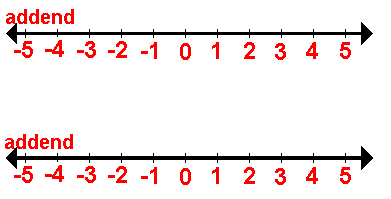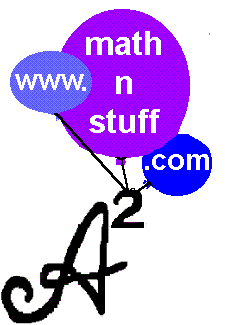Nomographs for Whole, Fraction, Decimal, and Signed Numbers
 |
A nomograph is set of 3 equally-spaced parallel number lines and a 4th line or string used to set up and complete an addition or subtraction.
A sheet of blank measured and spaced number line images are provided at the left. Click on the image for a printable page. |

This one is set up to show that the sum of -4 and +2 is -2.
- -4 the addend, is on the bottom line,
- 2 the addend, is on the top line,
- - 2, the sum, is on the middle line.
Components of a Nomograph
Each nomograph requires:
- A set of identical parallel number lines having scales lined-up one above the other.

- A middle or third number line placed parallel and midway between the first two.

- Each number on the middle number line is twice as large its corresponding
value on the outer number lines.
- A additional string or rigid line is needed to connect addends on the outer
lines and read the sum on the middle line.

- This rigid line must be able to reach from the left-most addend on the top line
- to the
- right-most addend on the bottom line.
To Use a Nomograph to Add
- Stretch the rigid line from an added on the top line to the
other addend on the bottom line.
- Read the sum at the intersection of the rigid line and
the middle number line.

To Use a Nomograph to Subtract
- Stretch the rigid line from the subtrahend on the top line through the minuend on the middle line
then continue the line to the bottom line.
- Read the remainder at the intersection of the rigid line and
the bottom number line.

It Takes All Kinds
Use different scales to make different nomographs.


A Nomograph Bulliten Board
Fill the bulliten board with directions, the 3 parallel number lines at a height convenient for students use. A string or stick must be available to strentch from -5 on the top to -5 on the bottom with the
string attached at the positive end of the number lines.

 |
© 2005, 2017, A2, www.mathnstuff.com/math/spoken/here/2class/130/nomogrf/nomo.htm
![[MC,i. Home, site home page]](//www.mathnstuff.com/math/spoken/here/1gif/mcihome.gif)
![[master list of all MSH! dictionary words]](//www.mathnstuff.com/math/spoken/here/1gif/words.gif)

![[Good Stuff -- free & valuable resources]](//www.mathnstuff.com/gif/goods.gif)
![[this semester's schedule w/links]](//www.mathnstuff.com/gif/semestr.gif)
|










![[MC,i. Home, site home page]](http://www.mathnstuff.com/math/spoken/here/1gif/mcihome.gif)
![[master list of all MSH! dictionary words]](http://www.mathnstuff.com/math/spoken/here/1gif/words.gif)

![[Good Stuff -- free & valuable resources]](http://www.mathnstuff.com/gif/goods.gif)
![[this semester's schedule w/links]](http://www.mathnstuff.com/gif/semestr.gif)